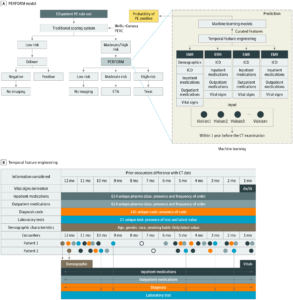

Explore This Issue
ACEP Now: Vol 40 – No 01 – January 2021Overview of the Pulmonary Embolism (PE) Prediction Pipeline, Pulmonary Embolism Result Forecast Model (PERFORM) (Click image to enlarge)
CC-BY License. © Banerjee I, et al. JAMA Netw Open. 2019;2(8):e1987198.
Also included in this category are direct patient care algorithms. For example, CLEW is a platform that analyzes data from critically ill patients to give a dynamic work list for the optimization of patient outcomes over the following metrics: venous thromboembolism prevention, lung protective ventilation, stress ulcer prophylaxis, blood transfusions, and accelerated mechanical ventilation weaning and liberation.
3. Communication: Are you ready to hear about an AI start-up with technology that has already been approved for Medicare reimbursement? Viz.ai detects large vessel occlusion (LVO) on head CT/CTA. It is integrated into imaging software and sees the images as they are being collected. If an LVO is detected, it sends a message to all the current and future caregivers of the patient, from ED nursing to the neurointerventionalist who may perform a procedure. In other words, the downstream caregivers might automatically receive a text message about a patient before they have even seen them, depending on your center’s stroke workflow. Knowing this, are you surprised centers that adopt Viz.ai have seen a 50 percent increase in interventions?
Regarding the technology, in comparison with an experienced neuroradiologist, the Viz.ai algorithm performs with very high sensitivity (though mediocre specificity), with an overall accuracy of about 80 percent. This means it catches almost all the LVOs and then some. All of the cases are then presented to the neurointerventionalist directly. That said, some of the evidence that endovascular intervention for LVO is better than the best medical management for even mild stroke symptoms (NIH Stroke Scale ≤5) has been published by the same people who are evaluating the efficacy of the Viz.ai algorithm. Conflict of interest, anyone? The same people also argue that ASPECTS, a radiology scoring system to determine LVO from noncontrast head CTs, performs better than CT angiogram of the head and neck for determining presence of important and intervenable LVOs. Viz.ai evaluates both noncontrast CT and CT angiograms.
Enter Medicare. Viz.ai has Food and Drug Administration (FDA) approval for its technology, and in a milestone decision made in August 2020, Medicare now reimburses for it. Interestingly, the model for Medicare reimbursement only comes into play if your center is not currently benefiting from increased revenues coming from an increased number of performed interventions. Thus, it is basically a consolation prize to the community hospitals that are losing stroke admission–related revenue to the interventional centers that would have previously never accepted transfer of such patients (or treated them directly). Of course, clot retrieval is not without risks. Hopefully, an increase in these procedures will provide patients more benefits than harm.
Other start-ups in radiology and pathology are conducting clinical analyses on other imaging and specimen evaluations and their effect on medical decision making. As with strokes, though, the validation studies are often completed by researchers who either own stock or stand to reap financial benefits from AI technologies. Does this necessarily negate the effectiveness of the technology? No. Should we demand better standards of validation research? Absolutely.
4. Billing: While not part of direct patient care, the myriad applications of AI to medical billing that are ongoing right now should be discussed. In general, billing is the most underappreciated and underdiscussed determinator of our practice in emergency medicine. Changes in reimbursement patterns can alter our practices. Arguably, AI was first introduced in health care for reasons related to medical billing, and this makes sense since the revenue benefits are easy to measure and immediately realized and recognized. For example, natural language processing is used to scan through charts to find diagnoses we forgot to include, add procedures we forgot to document, and add missing information needed to justify the billing codes we used. AI is also used to better understand coverage denials and to identify strategic areas for potential fair increases in revenues.
In terms of billing for their own “services,” AI start-ups are seeing success in getting FDA approval. Medicare reimbursement is the natural next step. For example, Digital Diagnostics came out with a technology called IDx-DR that can detect retinopathies mostly caused by diabetes. Its technology is used internationally and for a low cost and has shown to be instrumental in early detection of diabetic retinopathy. Another example: Caption Health received FDA approval to deploy Caption Guidance, which is used for helping ultrasound operators capture high-quality cardiac ultrasound images. It was tested on previously untrained nurses. These caregivers were found to be able to capture high-quality images using this technology. Both of these technologies could be readily and legally adopted into our workflows. In fact, the only thing preventing widespread adoption probably is the economics (ie, billing). Given the reimbursement model described above, the floodgates of Medicare reimbursement for AI can be considered open now. It is only a matter of time before we begin to see how AI changes our diagnostic algorithms.
5. Process improvement: Imagine changes in staffing recommendations being made by an algorithm rather than management. The reality is that this is already happening and not just for physicians, physician assistants, and nurse practitioners. AI algorithms are being used to make recommendations on nurse staffing in the emergency department as well. Could this be a good thing and an answer to our understaffing problems? Yes! Unfortunately, right now, the opposite has been happening. To implement any technology, a cost-benefit analysis has to be done. If a staffing algorithm promises to save a system money, then one easy way to do this is by cutting hours, not increasing them. That said, research on predictive models for staffing emergency departments has been described in academic literature. There are even algorithms that take into account surges in patient volume.
Other areas of process optimization using AI include patient flow, protocol initiation, and really almost any computer-based task. A platform called Olive is designed as a health care bot, or a “digital employee.” It assists hospital employees across many departments including revenue cycle, supply chain, information technology, human resources, finance, accounting, pharmacy operations, and clinical operations. Olive provides a timely pop-up of what it “thinks” is useful information based on what it has learned about the user so far. One example is in patient information verification.
Pages: 1 2 3 | Single Page





No Responses to “If Physicians Embrace Artificial Intelligence, We Can Make It Work for Us”